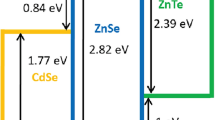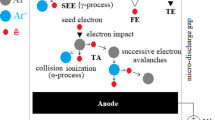Abstract
In this study, we investigate atmospheric microwave plasmas produced without electrodes while having a larger plasma volume in pure nitrogen. Optical emission spectroscopy is conducted to measure the translational, rotational, and vibrational temperatures of the plasma. Subsequently, three-temperature plasma kinetic simulations that consider the trans-rotational, vibrational, and electron temperatures separately are developed and conducted to study reaction pathways that sustain the plasma. The translational, rotational, and vibrational temperatures of the plasma are found to be the same and reach approximately 6000 K independent of the flow rate. In the plasma region, the molecular nitrogen is found to be dissociated into atoms to a significant extent because of the high gas temperature, and the plasma is sustained via associative ionizations rather than the electron-impact ionizations.
Similar content being viewed by others
References
A. R. Ravishankara, S. Solomon, A. A. Turnipseed and R. F. Warren, Atmospheric lifetimes of long–lived halogenated Species, Science, 259 (5092) (1993) 194–199.
J. Heberlein and A. B. Murphy, Thermal plasma waste treatment, J. Phys. D. Appl. Phys., 41 (5) (2008).
E. Gomez, D. A. Rani, C. R. Cheeseman, D. Deegan, M. Wise and A. R. Boccaccini, Thermal plasma technology for the treatment of wastes: A critical review, J. Hazard. Mater., 161 (2–3) (2009) 614–626.
W. T. Tsai, H.P. Chen and W. Y. Hsien, A review of uses, environmental hazards and recovery/recycle technologies of perfluorocarbons (PFCs) emissions from the semiconductor manufacturing processes, J. Loss Prev. Process Ind., 15 (2) (2002) 65–75.
T. Gierczak, R. Talukdar, G. L. Vaghjiani, E. R. Lovejoy and A. R. Ravishankara, Atmospheric fate of hydrofluoroethanes and hydrofluorochloroethanes: 1. Rate coefficients for reactions with OH, J. Geophys. Res., 96. D3 (1991) 5001–5011.
J. J. Orlando, J. B. Burkholder, S. A. McKeen and A. R. Ravishankara, Atmospheric fate of several hydrofluoroethanes and hydrochloroethanes: 2. UV absorption cross sections and atmospheric lifetimes, J. Geophys. Res., 96 (D3) (1991) 5013–5023.
D. T. Chen, M. M. David, G. V. D. Tiers and J. N. Schroepfer, A carbon arc process for treatment of CF4 Emissions, Environ. Sci. Technol., 32 (20) (1998) 3237–3240.
C. M. Du, J. H. Yan and B. Cheron, Decomposition of toluene in a gliding arc discharge plasma reactor, Plasma Sources Sci. Technol., 16 (4) (2007) 791–797.
H. S. Uhm, Y. C. Hong and D. H. Shin, A microwave plasma torch and its applications, Plasma Sources Sci. Technol., 15 (2) (2006) S26–S34.
H. Sun, J. Lee, H. Do, S. Im and M. S. Bak, Experimental and numerical studies on carbon dioxide decomposition in atmospheric electrodeless microwave plasmas J. Appl. Phys., 122 (2017) 033303.
S. M. Chun, Y. C. Hong and D. H. Choi, Reforming of methane to syngas in a microwave plasma torch at atmospheric pressure, J. CO2 Util., 19 (2017) 221–229.
X. Tao, M. Bai, X. Li, H. Long, S. Shang, Y. Yin and X. Dai, CH4–CO2 reforming by plasma–Challenges and opportunities, Prog. Energy Combust. Sci., 37 (2) (2011) 113–124.
H. S. Uhm, Y. H. Na, Y. C. Hong, D. H. Shin, C. H. Cho and Y. K. Park, High–efficiency gasification of low–grade coal by microwave steam plasma, Energy and Fuels, 28 (7) (2014) 4402–4408.
M. Jasiński, M. Dors, H. Nowakowska, G. V. Nichipor and J. Mizeraczyk, Production of hydrogen via conversion of hydrocarbons using a microwave plasma, J. Phys. D. Appl. Phys., 44 (19) (2011) 194002.
Y. F. Wang, Y. S. You, C. H. Tsai and L. C. Wang, Production of hydrogen by plasma–reforming of methanol, Int. J. Hydrogen Energy, 35 (18) (2010) 9637–9640.
Y. C. Hong, J. H. Kim and H. S. Uhm, Simulated experiment for elimination of chemical and biological warfare agents by making use of microwave plasma torch, Phys. Plasmas, 11 (2) (2004) 830–835.
Y. C. Hong, H. S. Uhm, H. S. Kim, M. J. Kim, S. H. Han, S. C. Ko and S. K. Park, Decomposition of phosgene by microwave plasma–torch generated at atmospheric pressure, IEEE Trans. Plasma Sci., 33 (2) (2005) 958–963.
M. Jasiński, J. Mizeraczyk, Z. Zakrzewski, T. Ohkubo and J. S. Chang, CFC–11 destruction by microwave torch generated atmospheric–pressure nitrogen discharge, J. Phys. D. Appl. Phys., 35 (18) (2002) 2274–2280.
J. Mizeraczyk, M. Jasiński and Z. Zakrzewski, Hazardous gas treatment using atmospheric pressure microwave discharges, Plasma Phys. Control. Fusion, 47 (12 B) (2005).
Y. Ko, G. Yang, D. P. Y. Chang and I. M. Kennedy, Microwave plasma conversion of volatile organic compounds, J. Air Waste Manage. Assoc., 53 (5) (2003) 580–585.
Y. C. Hong and H. S. Uhm, Abatement of CF4 by atmospheric–pressure microwave plasma torch, Phys. Plasmas, 10 (8) (2003) 3410–3414.
H. Kurihara and T. Yajima, Decomposition of toluene by atmospheric pressure microwave plasma generated using metal salt–impregnated carbon felt pieces, Chem. Lett., 36 (4) (2007) 526–527.
M. Leins, L. Alberts, M. Kaiser, M. Walker, A. Schulz, U. Schumacher and U. Stroth, Development and characterisation of a microwave–heated atmospheric plasma torch, Plasma Process. Polym., 6 (S1) (2009) S227–S232.
P. Jamróz, W. Kordylewski and M. Wnukowski, Microwave plasma application in decomposition and steam reforming of model tar compounds, Fuel Process. Technol., 169 (2018) 1–14.
B. A. Wofford, M. W. Jackson, C. Hartz and J. W. Bevan, Surface wave plasma abatement of CHF3 and CF4 containing semiconductor process emissions, Environ. Sci. Technol., 33 (11) (1999) 1892–1897.
J. Lee, H. Sun and M. S. Bak, Formation of nitrogen oxides from atmospheric electrodeless microwave plasmas in nitrogen–oxygen mixtures, J. Appl. Phys., 122 (8) (2017) 083303.
H. Sun, J. Lee, S. Im and M. S. Bak, Optical emission spectroscopic studies on atmospheric electrodeless microwave plasma in carbon dioxide–hydrogen mixture, IEEE Trans. Plasma Sci., 45 (12) (2017) 3154–3159.
J. Torres, J. M. Palomares, A. Sola, J. J. A. M. Van der Mullen and A. Gamero, A Stark broadening method to determine simultaneously the electron temperature and density in high–pressure microwave plasmas, J. Phys. D. Appl. Phys., 40 (19) (2007) 5929–5936.
D. Andrienko, Non–equilibrium models for high temperature gas flows, Ph.D. Thesis, Wright State University (2014).
E. V. Kustova and E. A. Nagnibeda, Kinetic model for multi–temperature flows of reacting carbon dioxide mixture, Chem. Phys., 398 (1) (2012) 111–117.
R. L. Macdonald, A. Munafò, C. O. Johnston and M. Panesi, Nonequilibrium radiation and dissociation of CO molecules in shock–heated flows, Phys. Rev. Fluids, 1 (4) (2016) 043401.
C. Park, Review of chemical–kinetic problems of future NASA missions. I–Earth entries, J. Thermophys. Heat Transf., 7 (3) (1993) 385–398.
G. J. M. Hagelaar and L. C. Pitchford, Solving the Boltzmann equation to obtain electron transport coefficients and rate coefficients for fluid models, Plasma Sources Sci. Technol., 14 (4) (2005) 722–733.
Phelps database, www.lxcat.net, September 29 (2016).
Morgan database, www.lxcat.net, September 29 (2016).
Free program distributed by NASA, www.grc.nasa.gov/WWW/CEAWeb/ceaThermoBuild/htm.
R. N. Gupta, J. M. Yos and R. A. Thompson, A review of reaction rates and thermodynamic and transport properties for an 11–species air model for chemical and thermal nonequilibrium calculations to 30000 K, Nasa Tech. Memo. (1990).
M. Capitelli, C. M. Ferreira, B. F. Gordiets and A. I. Osipov, Plasma kinetics in atmospheric gases, Springer, Berlin (2000).
A. Lifshitz, Correlation of vibrational de–excitation rate constants (k0←1) of diatomic molecules, J. Chem. Phys., 61 (6) (1974) 2478–2479.
A. Fridman, Plasma chemistry, Cambridge University Press, Cambridge (2008).
Author information
Authors and Affiliations
Corresponding author
Additional information
Recommended by Associate Editor Jeong Park
Hojoong Sun received the B.S. degree from the Mechanical System Design Engineering Department, Kyonggi University, Suwon, South Korea, in 2016. He is currently pursuing the Ph.D. degree with the School of Mechanical Engineering, Sungkyunkwan University, Suwon. His current research interests include fuel reforming, atmospheric pressure plasma and plasma-assisted technologies.
Jungwun Lee received the B.S. degrees in Mechanical Engineering from Sungkyunkwan University in 2017, where he is currently pursuing the M.S. degree with the School of Mechanical Engineering. His research interests include laser-induced plasmas, atmospheric microwave plasmas and plasma-assisted technologies.
Moon Soo Bak received the B.S. degree in mechanical and aerospace engineering from Seoul National University, Seoul, Korea, in 2007 and the M.S. and Ph.D. degrees in mechanical engineering from Stanford University, Stanford, CA, USA, in 2010 and 2014, respectively. He is currently an Assistant Professor with the School of Mechanical Engineering, Sungkyunkwan University, Suwon, Gyunggi-do, Republic of Korea. His current research interests include combustion, fluid dynamics, atmospheric pressure plasmas and plasma-assisted combustion.
Rights and permissions
About this article
Cite this article
Sun, H., Lee, J. & Bak, M.S. Characterization of atmospheric electrodeless microwave plasma in nitrogen. J Mech Sci Technol 32, 5999–6007 (2018). https://doi.org/10.1007/s12206-018-1150-4
Received:
Revised:
Accepted:
Published:
Issue Date:
DOI: https://doi.org/10.1007/s12206-018-1150-4




